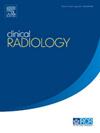定量脑合成磁共振成像对阻塞性睡眠呼吸暂停的诊断价值
IF 2.1
3区 医学
Q2 RADIOLOGY, NUCLEAR MEDICINE & MEDICAL IMAGING
引用次数: 0
摘要
目的探讨定量脑合成磁共振成像(SyMRI)对成人阻塞性睡眠呼吸暂停(OSA)合并脑微结构损伤的诊断价值。材料与方法收集50例初诊时未经治疗且确诊的OSA患者作为OSA组,36例非OSA患者作为正常组。随后,所有受试者使用GE SIGNA Architect 3.0T磁共振成像进行脑部扫描。同时比较两组患者脑灰质弛豫值、脑白质弛豫值、质子密度(PD)值的差异,并分析上述参数与呼吸暂停-低通气指数(AHI)的相关性。结果与正常组比较,OSA组脑灰质、白质T2值明显降低,脑灰质T1、PD值略有降低,差异有统计学意义(P<005)。同时,受试者工作特征曲线显示,白质T2值曲线下面积最高(AUC)为0.74,灵敏度高(92.0%),特异度低(52.0%)。灰质的T1和T2值AUC相同(0.69),分别具有高特异性(75.0%)和高灵敏度(92.0%)。Spearman相关分析显示,灰质T1值与AHI呈正相关,灰质和白质T2值与AHI呈负相关(P<0.05)。结论symri定量成像参数对成人OSA患者具有重要的临床价值,尤其是T2松弛值,有利于早期诊断脑微结构损伤。本文章由计算机程序翻译,如有差异,请以英文原文为准。
Diagnostic value of quantitative brain synthetic magnetic resonance imaging in patients with obstructive sleep apnoea
Aim
Investigating the diagnostic value of quantitative brain synthetic magnetic resonance imaging (SyMRI) in adult patients with obstructive sleep apnoea (OSA) and brain microstructural injury.
Materials and Methods
Fifty untreated OSA patients at initial diagnosis who were diagnosed were collected as the OSA group, with 36 non-OSA patients as the normal group. Afterwards, all subjects underwent cranial scans using GE SIGNA Architect 3.0T magnetic resonance imaging. Meanwhile, the differences in grey matter relaxation values, white matter relaxation values, and proton density (PD) values between the 2 groups were compared, followed by an analysis of the correlation between the above parameters and apnoea–hypopnoea index (AHI).
Results
Compared with the normal group, T2 values of grey and white matter were significantly decreased, and T1 and PD values of grey matter were slightly decreased in the OSA group, with significant differences (P<005). In the meantime, receiver operating characteristic curves suggested the highest area under the curve (AUC) (0.74) and a high sensitivity (92.0%) of T2 values of white matter, along with a low specificity (52.0%). Additionally, the T1 and T2 values of grey matter shared the same AUC (0.69), which exhibited high specificity (75.0%) and high sensitivity (92.0%), respectively. Furthermore, Spearman correlation analysis indicated that T1 values of grey matter were positively correlated with AHI, while T2 values of grey and white matter were negatively correlated with AHI (P<0.05).
Conclusion
SyMRI quantitative imaging parameters are of significant clinical value for adult OSA patients, especially T2 relaxation values, which are beneficial for the early diagnosis of brain microstructural injury.
求助全文
通过发布文献求助,成功后即可免费获取论文全文。
去求助
来源期刊

Clinical radiology
医学-核医学
CiteScore
4.70
自引率
3.80%
发文量
528
审稿时长
76 days
期刊介绍:
Clinical Radiology is published by Elsevier on behalf of The Royal College of Radiologists. Clinical Radiology is an International Journal bringing you original research, editorials and review articles on all aspects of diagnostic imaging, including:
• Computed tomography
• Magnetic resonance imaging
• Ultrasonography
• Digital radiology
• Interventional radiology
• Radiography
• Nuclear medicine
Papers on radiological protection, quality assurance, audit in radiology and matters relating to radiological training and education are also included. In addition, each issue contains correspondence, book reviews and notices of forthcoming events.
 求助内容:
求助内容: 应助结果提醒方式:
应助结果提醒方式:


